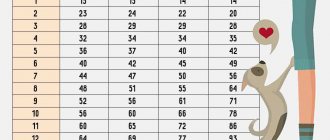So, you are thinking about breeding or have already bred your dog and now you want to know the dynamics that come after the first litter of puppies. Read on and find out how many times a dog gives birth a year.
When talking about breeding, the number of times and how often a dog can be bred, it should be remembered that they all depend on several factors.
Breeding a dog can be a healthy process that helps your dog lead an even healthier life and improve its growth. But, if not done appropriately, it can be a health hazard and affect your dog's overall health.
What determines the number of puppies in a litter?
Neither the owner himself nor the veterinarian will be able to guess just by looking at a pregnant bitch how many fetuses are in her womb. However, you can try to find out how many puppies a dog can give birth to, based on the following data:
- Dimensions (breed) of a pregnant dog
. As a rule [1], the number of puppies per litter is higher for large breed dogs (7-8 or more) because, from a biological point of view, they can safely bear more puppies. Miniature pets usually give birth to 1 to 4 babies. Although there are exceptions to this rule. There is evidence that some baby Pekingese can give birth to up to 10 puppies; - Bitch's age
. Usually there are few puppies in young dogs under the age of 1.5 years (1-2 puppies in small breed dogs and no more than 4 in large breeds). And dogs over 5-6 years old, as a rule, also have few babies in their litter. Maximum [1] puppies are born to bitches who are between 2 and 5 years old; - Male age
. The number of puppies also depends on how old their father is [1]. Young males aged 1-1.5 years and older dogs have low sperm quality, which affects the number of offspring; - Order of birth
. The first time, bitches, regardless of age, give birth to fewer puppies than the second time. And the third and fourth births account for the most numerous litters [1]. After this point, litters tend to get smaller with each successful mating. For example, tiny Chihuahuas in the first litter produce no more than 2 babies, and in the third they can already give birth to 3-4 cubs; - The dog's health during pregnancy and before birth
. Everything is simple here: the physically stronger the dog, the stronger its immunity, the higher the chances that it will be able to safely bear a large number of puppies. Thus, a healthy small mongrel is capable of giving birth to more puppies than a purebred large dog, whose condition leaves much to be desired. Ideally, before mating, the owner should show his four-legged pet to a veterinarian and make sure that everything is in order with her health; - Dog weight
. Few puppies in a litter usually occur in dogs whose weight is far from normal. Moreover, this applies to both animals with insufficient body weight and pets with obesity; - Season
. There is evidence [1] that in the spring, bitches give birth to a larger number of cubs compared to other times of the year (the smallest number of doggies is born in the cold season, that is, in late autumn and winter); - Natural or artificial fertilization (insemination)
. Almost always [2] with natural insemination, when a bitch has contact with a male, more puppies are born in the litter than with artificial insemination. This is due to the fact that during artificial insemination, sperm partially die during the collection and storage of the male’s semen.
Signs of a false pregnancy in a bulldog
French bulldogs and other dog breeds can experience an imaginary, or in other words, false pregnancy. This condition is characteristic of females who mate irregularly or do not mate at all.
Symptoms of false pregnancy in the French are:
- restless behavior of the dog, an attempt to find a nest for future offspring;
- increased irritability, severe anxiety;
- The Frenchman begins to bring various objects (usually soft toys) to the bed. The female mistakes them for puppies, licks them and even tries to feed them;
- enlargement of the abdomen and swelling of the mammary glands. Sometimes milk comes out of the nipples;
- Rarely, but it is possible to simulate childbirth in a French bulldog.
The presence of these symptoms requires contacting a veterinarian. The veterinarian examines the dog and prescribes a dairy-free diet and sedatives. Additionally, you need to walk the dog more often and play with it.
After mating, some French bulldogs experience a phenomenon called frozen pregnancy. Recognizing it is quite simple: at about the eighth week of gestation, the bitch’s temperature rises and there is no movement in the abdomen.
Accurate ways to find out the number of puppies
Of course, you can't rely entirely on a dog's age and, say, its weight to know how many puppies there will be in a litter. More reliable information can be obtained using an ultrasound, which is performed on bitches after the 25th day of pregnancy (veterinarians sometimes use ultrasound only to confirm pregnancy, and not to count the number of puppies). You can even more accurately determine the number of puppies using x-rays, but such a study is most informative only after the 55th day of pregnancy, when the skeleton of the puppies is fully formed. By the way, during the X-ray examination, the doctor will determine the position of the fetuses and decide whether the dog will need help during childbirth.
By the way, some owners, trying to calculate the number of fetuses in the dog’s womb, use the palpation method by pressing on the belly of their pregnant pet. You shouldn't do this! And not only because it is very difficult to find puppies. Just strong pressure can damage fragile babies, as well as cause pain to a pregnant animal.
How to care for a bitch during pregnancy?
In order for the bulldog to give birth without complications and the puppies to be healthy, it is important to properly care for the pregnant girl. And the basic requirements are imposed on her diet. Until the fourth week, the French bulldog's menu has not yet changed, but it is already prohibited to treat it for parasites. Starting from the fourth week, you need to reduce the dog’s level of physical activity. At the same time, the Frenchman’s diet gradually changes:
- To begin with, the bulldog's menu includes more protein foods. This is lean meat, fish, homemade cottage cheese. You can add greens to porridges and soups.
- From the sixth week, the amount of incoming carbohydrates is reduced. That is, cereals, vegetables or bran should be given less often. Raw vegetables or fruits should be finely chopped before serving, or even better, grated. The frequency of feeding increases to three times a day.
- From the seventh week, feeding occurs four times a day. Heavy foods that are difficult to digest in the stomach are excluded from the diet. The meat is temporarily exchanged for ocean fish (on the basis that 100 grams of meat are equivalent to 150 grams of fish).
- One week before your female French Bulldog gives birth, remove any potential allergens from her diet. Feeding frequency is five times a day, while the total calorie content of the entire menu is reduced. You can give the girl vitamin and mineral supplements.
Despite the long period, it is impossible to completely give up physical activity. This threatens the French Bulldog with obesity and muscle weakness. Subsequently, this leads to difficult childbirth. You need to continue walking the dog, you just need to avoid excessively intense exercise, and especially jumping. In addition, swimming (in open reservoirs) and walking in the cold or heat are prohibited.
The closer the birth is, the more often you need to take your French bulldog outside. Due to the enlargement of the uterus, the dog begins to have a frequent urge to urinate.
How many puppies do females of popular breeds give birth to?
Now let's look at how many puppies are born to dogs of these 30 popular breeds:
- Chihuahua – 2-5 puppies [4];
- Yorkshire Terrier – 2-5 puppies [4];
- Russian Toy Terrier – 2-5 puppies;
- Pekingese – 2-4 puppies;
- Pomeranian Spitz – 2-3 puppies;
- Pug – 4-6 puppies;
- Dachshund – 2-5 puppies;
- American Cocker Spaniel – 3-7 puppies [4];
- French bulldog – 3-6 puppies;
- Welsh Corgi – 2-5 puppies;
- Jack Russell Terrier – 2-5 puppies;
- Beagle – 5-7 puppies;
- Bull Terrier – 3-7 puppies;
- Sheltie – 2-6 puppies [4];
- Akita Inu – 3-7 puppies;
- Shar Pei – 3-5 puppies;
- Siberian Husky – 7-9 puppies;
- Dalmatian – 8-12 puppies;
- Pitbull – 7-10 puppies;
- German Shepherd – 4-9 puppies [4];
- Collie – 6-10 puppies;
- Great Dane – 8-12 puppies;
- Doberman – 7-9 puppies;
- Labrador Retriever – 5-10 puppies [4];
- Golden Retriever – 7-12 puppies;
- Rottweiler – 8-11 puppies;
- Cane Corso – 8-12 puppies;
- Central Asian Shepherd Dog (Alabai) – 9-12 puppies;
- St. Bernard – 9-12 puppies;
- Bullmastiff – 5-13 puppies [1].
Of course, data on the number of puppies in females of various breeds is very approximate. For example, for the first time a young collie may have one puppy in the litter, but in the future she will be able to give birth to 10 babies at once. And a Pekingese dog, as already mentioned, can give birth to a dozen children, although on average these bitches bear up to 6 puppies.
Signs of impending labor in a bitch
Harbingers of imminent labor in a French bulldog at different stages of pregnancy are:
- per week: sagging abdomen, hollow sides;
- within five days: white discharge appears from the loop. This is the exit of the mucus plug;
- in one or two days: swelling of the nipples, release of colostrum;
- per day: frequent urination, loss of water;
- within 8-12 hours: decrease in body temperature (to 36.6 degrees).
Before giving birth, the Frenchman's behavior changes dramatically. The dog completely refuses to eat and settles down in a pre-equipped nest. During contractions, the dog feels severe pain, so it whines loudly and worries. Girls who give birth for the first time worry the most. They begin to drink a lot of water and rush around the apartment from corner to corner. During contractions, the Frenchman's breathing quickens and his heart rate increases. If you place your hand on your French Bulldog's tummy, you can feel the uterus tense and relax.
When there are 30-60 minutes left before the birth of the puppies, and the pregnancy period has come to an end, the Frenchie bitch squats and arches her back, while stretching her front legs forward. Before giving birth, the female French bulldog lies on her side.
Record-breaking dogs
Some might be shocked if their pet gives birth to 10 or 12 puppies. But this is far from the limit! History knows of cases where dogs gave birth to more than one and a half or even two dozen babies at a time:
- Rottweiler Terry from the UK gave birth to 18 puppies [5]. Unfortunately, 2 babies turned out to be weak and soon died;
- Also, 18 puppies were born [6] to the Dalmatian Miley from Australia. The dog's birth lasted, by the way, more than 12 hours;
- In Voronezh, a Cane Corso dog named Kira [7] gave birth to 19 puppies. All cubs survived;
- Neapolitan Mastiff Tia became the mother of 24 puppies, which is a [3] world record and is recorded in the Guinness Book of Records. Although on average up to 12 puppies are born to dogs of this breed.
Giving birth to a French bulldog
First of all, the owner of a French bulldog needs to prepare for childbirth. The first thing you need to do is arrange an ideal place for the birth of future puppies. For a pregnant female you need to have a convenient box (or drawer). She will give birth in it. The size of the box is determined as follows: it is necessary that the female can easily rest her back and paws against the walls. This body position will make it easier for her to endure pushing. An oilcloth and an old warm blanket are placed at the bottom of the box.
The room where the French bulldog will give birth should be light, clean and warm. The female Frenchie is pre-washed with warm water and hypoallergenic soap. Then the dog is rinsed with slightly diluted potassium permanganate. The hair in the area of the nipples and loops should be cut off.
During the birth of a French bulldog, the owner should have the following things on hand:
- gauze, disposable diapers, towels. Everything must be clean and sterile;
- oilcloth;
- potassium permanganate solution;
- alcohol;
- iodine;
- Vaseline oil;
- thermometer and room thermometer (to monitor the temperature in the room);
- syringes;
- sterile cotton wool;
- special scissors with curved tips;
- sterile and strong cotton thread;
- electronic balance;
- a bowl of clean water;
- Oxytocin ampoules;
- notepad, pen.
The birth of pregnant French bulldogs consists of two stages - preparation and the birth itself. The preparatory stage of childbirth lasts from six to thirty hours. It is characterized by the following symptoms:
- opening of the birth canal;
- contractions of the uterus.
If the female’s temperature rises to 39 degrees, bloody or purulent discharge from the loop, or constipation appear, this indicates a complicated course of labor.
After the preparatory stage of childbirth, pushing begins. Puppies are born at intervals of 10 to 60 minutes. If two hours have passed since the birth of the last baby, labor can be considered completed. And then the Frenchman needs to be injected with Oxytocin.
Usually, the French bulldog independently bites off the umbilical cord after birth, frees the babies from the placenta and licks them. But if the girl is tired, then the owner must take on part of the work. By the way, there is no need to prohibit the Frenchie from eating the placenta after giving birth - it contains many nutritional components for the dog. But you should not give the girl more than two fetal sacs, otherwise she will experience digestive upset.
Why Litter Size Matters
When a small dog has a large litter, the risk of complications during pregnancy and birth increases. Knowing how many puppies your dog is expecting will help you and your veterinarian develop a safe birth plan for her. Getting an idea of how many puppies will be born will also ensure that you provide your dog with a puppy crate large enough to comfortably fit a young family in the first few weeks and will allow you to stock up on puppy supplies.
Possible complications during labor
French bulldogs, unfortunately, often carry offspring and give birth with complications. Common pathological conditions include:
- false pregnancy;
- fading of pregnancy, which leads to the death of offspring;
- ectopic pregnancy;
- insufficient intensity of uterine contractions during pushing;
- infection of the birth canal (often purulent);
- mastitis. This is an infection of the mammary glands in a Frenchman, which is characterized by an inflammatory process, discharge of pus and high temperature.
- lack of colostrum after the birth of puppies.
- large fruits or their incorrect position. This is the main indication for a cesarean section.
- tetany is a serious complication in which the level of calcium in the blood of a Frenchman decreases to a critical minimum. Symptoms include tremors, partial paralysis and severe weakness.
- eclampsia (a form of late toxicosis). A condition in which a female's blood pressure rises critically. Can be deadly.
- mother's refusal of puppies.
Get an ultrasound
When your dog reaches the 25-day mark of pregnancy, your veterinarian may suggest an ultrasound to count the puppies. An ultrasound machine uses sound waves to create an image of your dog's uterus so your veterinarian can count his puppies.
Ultrasound is completely safe for both the mother dog and her future puppies, but, like palpation, it is not reliable. If the puppies are positioned on top of or behind each other, the ultrasound may show one puppy when there are actually two. Again, the amount your vet gives you is an estimate, not a fact. Sometimes veterinarians use ultrasounds only to confirm pregnancies and not to count them.
Treatment of fever and prevention of allergies after vaccination
An increase in temperature is a normal reaction of the child’s body to a vaccination, which means that the immune system has responded to the vaccine and is beginning to develop immunity (however, the absence of an increased temperature after vaccination does not mean that the vaccination was ineffective). In the case of completely healthy children, the temperature should not be lowered after vaccination if it does not exceed 38.5C. In cases of a more significant increase in temperature, and also when the temperature remains at 38.5 C in the evening, the child should be given an antipyretic. To treat fever after vaccination, it is recommended to use Paracetamol. Aspirin should never be used as an antipyretic in children.
In the case of children with a tendency to febrile convulsions, treatment should be started when the temperature rises above 37.5 or the child should be given an antipyretic before the temperature appears, if so advised by the neurologist observing the child.
Prevention of allergic reactions after vaccinations is indicated only in the case of children prone to developing allergies. In such cases, it is recommended to use Suprastin or another antihistamine as prescribed by a doctor.
Treatment of redness and swelling at the injection site
Most vaccinations result in more or less severe redness or swelling at the injection site. The most severe local reaction to vaccination is observed in the case of DTP (redness, swelling and pain at the injection site) and BCG (formation of a long-lasting non-healing ulcer). For all types of vaccinations, it is recommended to avoid any local treatment for redness or swelling at the injection site. If the child scratches the injection site, it can be covered with a light gauze bandage. At the site of the DTP, a compaction often forms, located deep in the muscle - a “bump”. Often such a lump is painful, and the child easily limps on one leg (if the vaccine was injected into the thigh). The formation of a dense “bump” after DPT is considered a normal reaction and does not require any treatment. Within a few weeks, the lump will resolve on its own.
Getting the number
The best way to accurately calculate how many puppies you are expecting is to get an x-ray. Around the 45th day of pregnancy, the puppy's bones begin to harden and mineralize, making them visible on x-rays. Your veterinarian can then count the number of skulls or spinal cords present in the uterus to get a more accurate number of puppies.
Although skeletal mineralization begins around day 45, many veterinarians wait until day 55 to take x-rays. This gives the puppies' bones time to fully harden and ensures the most accurate count. This also means only one x-ray is taken late in pregnancy, minimizing radiation exposure to future puppies. This also allows the veterinarian to ensure that all puppies are in the correct position for a smooth birth.
However, even with X-ray examination, erroneous calculations are possible. The growing puppies begin to run out of space in the womb and end up huddled together. Depending on how they are positioned, one or two puppies may be able to hide from the X-ray machine.
Source
Impact of artificial insemination
If you want to breed your dog, you can either introduce him to a suitable male and let nature take its course, or you can artificially inseminate him. Both methods work, but natural insemination produces larger litters. Smaller litters occur with artificial insemination because some sperm inevitably die during the collection, storage and fertilization processes.
© shutterstock
Although it produces smaller litters, artificial insemination is an excellent way to produce an uncooperative female who for some reason does not like her partner. This also allows deceased dogs with excellent personalities and breed characteristics to produce additional generations of offspring after their death. If you're worried about how your dog will handle a large litter, artificial insemination can help you control the size of the litter and make things more manageable.
How to properly deliver a bitch?
Since most French Bulldog owners give birth at home, you need to know a few basic rules:
- You can't leave the dog alone. She needs her owner's support.
- If the amniotic sac did not rupture at the birth of the puppy, you need to do it yourself. After this, use a gauze napkin to wipe the baby’s mouth from the accumulated viscous mucus. If this is not done, the puppy will suffocate. Then you need to tie the umbilical cord with a strong, clean thread. This is done at a distance of 1-2 centimeters from the puppy’s tummy. The umbilical cord is then cut with sterile scissors slightly higher than the thread. The edge of the umbilical cord should be treated with iodine and the baby should be given to the mother.
- Already born puppies should be placed in a pre-prepared box, which will contain a heating pad.
- After birth, each baby must be weighed and the result recorded. To avoid confusion, puppies are marked with multi-colored ribbons.
- In between the births of cubs, you need to give the female a drink of water and wash her tummy with a solution of potassium permanganate.
- Any deviations from the normal course of labor and obvious complications require urgent contact with a veterinarian.
If the owner thinks that he cannot cope, it is better to give birth to a French bulldog with an assistant or a veterinarian.











